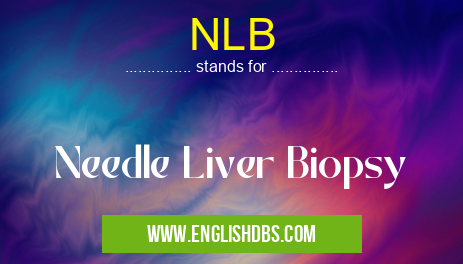What does NLB mean in UNCLASSIFIED
NLB stands for Needle Liver Biopsy, a medical procedure involving the extraction of a small sample of liver tissue for examination under a microscope. It is a common method used to diagnose and assess liver diseases.

NLB meaning in Unclassified in Miscellaneous
NLB mostly used in an acronym Unclassified in Category Miscellaneous that means Needle Liver Biopsy
Shorthand: NLB,
Full Form: Needle Liver Biopsy
For more information of "Needle Liver Biopsy", see the section below.
Purpose of NLB
- To determine the cause of abnormal liver function tests or symptoms
- To diagnose liver diseases such as hepatitis, cirrhosis, or liver cancer
- To assess the severity of liver damage
- To monitor the response to treatment
Procedure
NLB is usually performed with the patient lying on their right side. The doctor inserts a thin needle through the skin into the liver. The needle is moved around to obtain multiple samples of liver tissue. The procedure typically takes a few minutes and may cause some discomfort or pain.
Risks and Complications
NLB is generally a safe procedure, but as with any medical procedure, there are some potential risks and complications:
- Bleeding or bruising at the puncture site
- Infection
- Rarely, damage to nearby organs
Essential Questions and Answers on Needle Liver Biopsy in "MISCELLANEOUS»UNFILED"
What is a needle liver biopsy (NLB)?
A needle liver biopsy is a medical procedure that involves removing a small sample of tissue from the liver using a thin needle. This sample is then examined under a microscope to evaluate the liver's health and identify any abnormalities.
Why is a needle liver biopsy performed?
A needle liver biopsy may be recommended to:
- Diagnose liver diseases, such as hepatitis, cirrhosis, and fatty liver disease.
- Assess the severity of liver damage.
- Monitor the effectiveness of liver treatments.
- Identify the cause of unexplained liver problems or abnormal liver tests.
How is a needle liver biopsy performed?
A needle liver biopsy is typically performed in an outpatient setting. The procedure involves:
- Numbing the area of the abdomen where the biopsy will be taken.
- Inserting a thin needle into the liver to extract a small tissue sample.
- Applying pressure to the biopsy site to stop any bleeding.
Are there any risks associated with a needle liver biopsy?
While needle liver biopsies are generally safe, there is a small risk of complications, including:
- Bleeding
- Infection
- Pain or discomfort
- Damage to nearby organs
- Bruising or swelling at the biopsy site
How should I prepare for a needle liver biopsy?
Before a needle liver biopsy, your doctor may instruct you to:
- Fast for several hours before the procedure.
- Stop taking certain medications or supplements that may increase the risk of bleeding.
- Inform the doctor about any allergies or medical conditions you have.
What happens after a needle liver biopsy?
After a needle liver biopsy, you will be monitored for any complications. You may experience some pain or discomfort at the biopsy site, which can be managed with over-the-counter pain relievers. The liver biopsy results typically take a few days to process.
Can a needle liver biopsy be used to treat liver disease?
A needle liver biopsy is primarily a diagnostic procedure and is not used to treat liver disease. However, the results of the biopsy can help guide treatment decisions and monitor the effectiveness of therapies.
Final Words: NLB is a valuable diagnostic tool that provides important information about liver health. While it is a safe procedure, it is essential to understand the potential risks and benefits before undergoing the biopsy.
NLB also stands for: |
|
| All stands for NLB |
